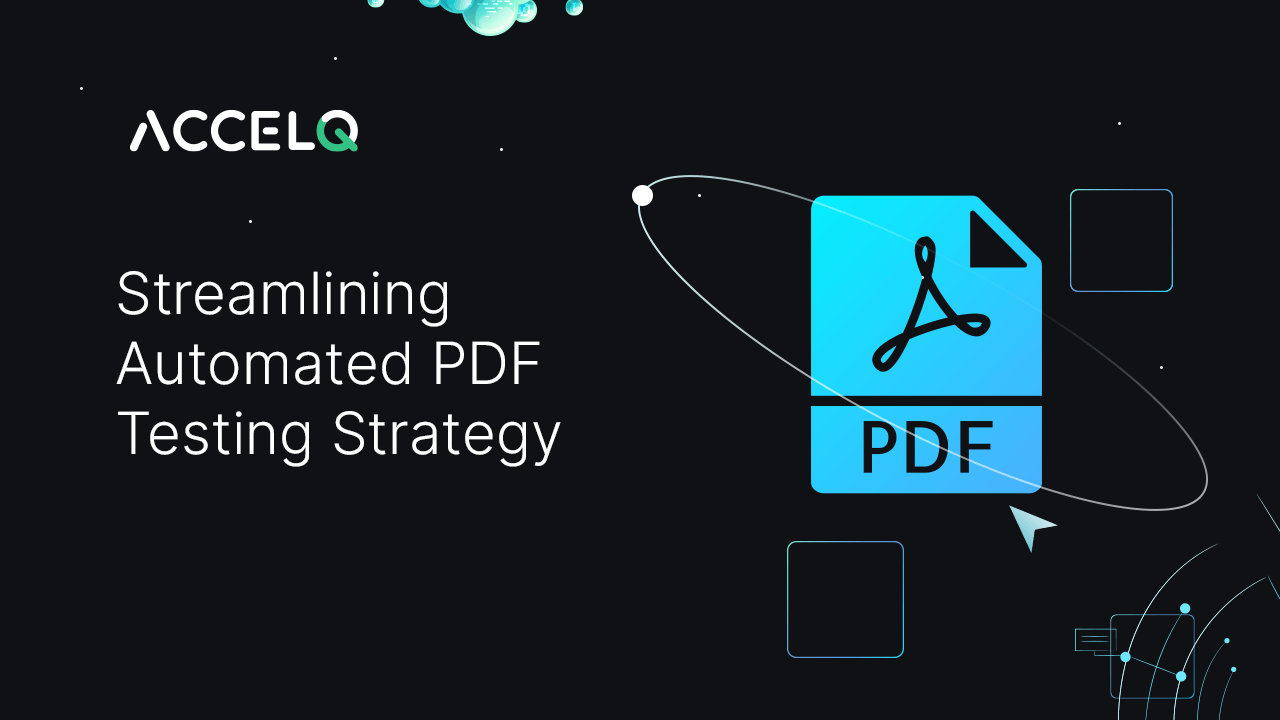How Important Is PDF Test Automation?

PDFs are the cornerstone of business communications, legal proceedings, and educational materials, holding the intricate details of transactions, proposals, and research. But what happens when these documents are not perfect? A single error in a PDF can disrupt financial operations, mislead legal judgments, or distort educational content. PDF test automation is a sophisticated blend of technology and precision that ensures every PDF that passes through your digital doors is flawless.
What Is PDF Testing?
PDF testing is a part of the process within the software quality assurance testing process. It is for verifying PDF file's accuracy, functionality, and reliability. These files for business and personal use are frequent and serve as a standard, reliable exchanging and preserving documents regardless of software, hardware, or operating system.
Why PDF Testing: The primary aim of PDF testing is to ensure that PDF documents render correctly across various platforms and devices and that their content, including text, images, and embedded formats, remains unaltered and accessible. This testing also ensures that interactive features like hyperlinks, form fields, and buttons work as intended.
Key Components of PDF Testing:
- Content Verification: This involves checking the textual and graphical content against predefined criteria to ensure accuracy. For instance, verifying that the text matches the original documents or that the images are placed and scaled correctly.
- Layout and Formatting: Testing the layout involves ensuring the document adheres to specific formatting rules, such as margins, font sizes, and alignment. This is crucial for documents that must meet strict compliance and branding standards.
- Functionality Testing: Functionality testing for PDFs that include interactive elements like forms or links is essential and directly impacts the user experience. This testing ensures that all interactive components operate correctly, enhancing the user experience and functionality of the document. Your work in this area directly contributes to user satisfaction.
- Compatibility and Rendering: Ensures that PDFs look and function identically across different viewing platforms, such as web browsers, PDF readers, and mobile devices. This is critical for maintaining consistency in user experience and document reliability.
- Security Testing: This aspect checks the PDF for vulnerabilities that could potentially be exploited. It also verifies that security features like encryption and access controls function as expected.
How to do PDF Automation Testing?
PDF testing automation strategy document PDF involves unique considerations due to their fixed layout formats and diverse content types.
1. Tool Selection: Choose a PDF test automation tool that specifically supports PDF interactions. The tools to extract text, verify formatting, check metadata, and even compare PDF documents at a structural level.
2. Environment Configuration: Choose a PDF test automation tool that specifically supports PDF interactions. The tools to extract text, verify formatting, check metadata, and even compare PDF documents at a structural level.
3. Script Development for PDF Features:
- Content Extraction Tests: Write scripts to extract and verify text content using regular expressions or comparison methods.
- Format Validation: Develop tests to check the PDF format for font embeddings and color spaces in accordance with the specified standard.
- Graphical Element Verification: Implement scripts to verify graphical elements for image resolution, verify page placement, and confirm vector graphics scale.
- Interactive Features Testing: Write scripts to test form field functionality for PDFs containing forms or interactive elements.
4. Automated Test Execution: Run the tests using test automation tools to execute tests each time a PDF is generated or updated.
5. Results Analysis and Reporting: Use detailed logging and reporting tools to analyze the outcomes of your PDF tests on text, format validations, and graphical consistencies./p>
6. Continuous Improvement and Integration: Implement a feedback loop into your development process to improve the quality of PDF outputs continuously
Example of Automated PDF Testing
Scenario: Ensuring the accuracy and proper formatting of a PDF invoice generated after an online transaction.
| Step | Description | Expected Outcome |
|---|---|---|
| PDF Extraction | Initialize PDF parsing and load the document. Extract text from fields like invoice number and date. | Text data is extracted accurately for verification. |
| Content Verification | Compare the extracted text against predefined expected results for accuracy. | Extracted text matches predefined data, confirming the accuracy of the content. |
| Layout and Format Validation | Verify that text aligns correctly within the page margins and that table alignments are consistent. | PDF layout is consistent with the specified standards, ensuring proper alignment and formatting. |
| Results Handling | Log results, noting any discrepancies or failures. Review failed tests to identify issues. | A comprehensive log of test results is created, issues are identified, and documents are reviewed. |
Strategies to Overcome the Challenges
Challenge: Text Extraction Accuracy
Solution: Implement advanced Optical Character Recognition (OCR) technologies. Regularly update your OCR tools to handle different fonts and layouts and include fallback mechanisms to verify text extraction through multiple methods.
Challenge: Maintaining Layout Consistency
Solution: Use layout comparison tools to ensure each document maintains a consistent format. Automate screenshots of each PDF page to compare with a standard layout template using image comparison algorithms.
Challenge: Cross-Platform Rendering
Solution: Test PDFs on multiple platforms and devices to ensure uniform appearance and functionality. Employ virtual machines or device emulators to automate cross-platform testing efficiently.
Conclusion
PDF testing ensures that every PDF document your organization creates meets the highest quality and consistency standards and uncovers flaws. Thorough testing builds user trust and ensures regulatory compliance. Accept and use the test automation strategy PDF and solutions provided by ACCELQ in your testing plan. Digital document success requires precision and dependability, which our team assures you with the proper strategic plan for your requirements.
Geosley Andrades
Director, Product Evangelist at ACCELQ
Geosley is a Test Automation Evangelist and Community builder at ACCELQ. Being passionate about continuous learning, Geosley helps ACCELQ with innovative solutions to transform test automation to be simpler, more reliable, and sustainable for the real world.
Related Posts
 How Cross-Browser Testing Enhances User Experience?
How Cross-Browser Testing Enhances User Experience?
How Cross-Browser Testing Enhances User Experience?
 Effective Strategies for Testing Your Flutter Apps
Effective Strategies for Testing Your Flutter Apps
































